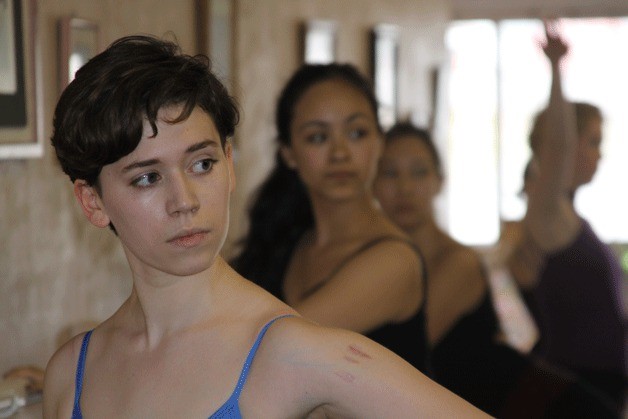In the final dress rehearsal for “Peter Pan,” last year, Ellen Peterson put all her weight on her extended left foot and felt a pop.
It was her Achilles, a tendon that is constantly tested when ballet dancers stand on their toes. The pop was an alarm and the pain that followed a cause for some initial panic.
She was, after all, playing Peter Pan.
“I was the main,” she said. “I had to continue.”
With the aid of anti-inflammatories, a lot of ice and some comfort from a physician’s diagnosis, Peterson performed in four shows during that weekend last June before giving her foot an extended rest.
Peterson, 16, from Coupeville, is back at it again this month, ready to embrace a lead role in another production put on by the Ballet Slipper Conservatory June 14-15 at Oak Harbor High School.
This time, she will be starring in “Aladdin.”
Coping with aches, pains and the occasional pop is something ballet dancers understand is part of the routine.
Diane Geragotelis, who’s taught classes at her Ballet Slipper studio in Oak Harbor since 1991, tries to teach proper techniques to prevent injuries but knows not everything is in her control.
“Your body is doing things it’s not supposed to do,” she said.
Still, students come to learn more. And keep coming back.
Kelli Spence, 30, takes ballet classes from Geragotelis four times a week and will dance in the role of the Sultan in “Aladdin.”
Spence, from San Antonio, Texas, has been involved with ballet since she was 3. As she’s gotten older, she’s enjoyed the fitness aspect of it.
“Dancing is just a part of who I am,” Spence said. “I quit for a while after college, but I couldn’t stay away for long.”
Spence laughs about the physical toll ballet takes on her body but couldn’t imagine giving it up.
“I see a physical therapist almost every week,” she said.
Aches associated with ballet are most frequently related to ankles, feet, calves, hips, hamstrings and lower back.
When dancers go “on pointe” by rising and putting all of their weight on their big toe, “they say it’s equivalent to an elephant stomping on your foot,” Geragotelis said.
A bad landing from a jump can result in the occasional broken bone, something Geragotelis remembers happening only a handful of times in her 21 years of teaching and only once during a performance about seven years ago.
“Everybody heard the snap,” Geragotelis said, “then she continued to dance on it. She wouldn’t come off the stage.”
When she did leave the stage, she collapsed, revealing the sort of mental toughness that also seems to be a part of the makeup of many dedicated ballet performers.
“It’s mentally and physically challenging,” Geragotelis said. “Through life and through teaching the people who do this, I’ve found them to be perfectionists. If they weren’t perfectionists, there is no way they’d put their bodies through everything they have to do physically and mentally. You have to be on all the time and thinking all the time.”
Spence considers ballet as much of a sport as it is art, involving considerable strength and flexibility. Dancers accomplish acrobatic moves such as jumps, toe stands and high leg extensions.
“You’re always pushing yourself to get better,” Spence said. “There’s no ceiling you can hit in dancing. Sometimes, you push too hard.”
Peterson, in ballet since she was 4, continues to push and build on her dancing skills. She also regularly travels to Bellingham take classes in jazz, hip hop and contemporary dance.
She sees herself teaching dance one day and also envisions performing with a dance company.
“She’s very good,” Geragotelis said. “I definitely think she’ll go on to dance, whether it’s ballet, hip hop or jazz. She’s not going to give up dancing.”
Dancing in the lead role in a ballet performance is nothing new. She’s also played Alice in “Alice in Wonderland.”
In “Aladdin,” she teams up with Chelsey Kosbar, 14, who dances in the role of Jasmine, and Kumi Kosbar, Chelsey’s mother, who plays Jafar.
Ainsley Nelson, a 9-year-old who attends Oak Harbor Christian School, dances the part of Abu.
“It’s a funny character,” Nelson said.
Peterson said she’s honored playing Aladdin and likes how Geragotelis put the show together from the costumes to the music.
“I really love Aladdin,” Peterson said. “It’s so much fun to learn. We incorporated a little more acrobatics with Jasmine. She’s doing a lot more flexibility stunts.”
When a performer makes something difficult look effortless, that’s the sign of a talented dancer, Geragotelis said.
“I would definitely consider ballet a sport,” Peterson said. “It’s extremely demanding and physically exhausting. But it’s so worth it when you’re on the dance stage and you hear people clapping.”
It’s Aladdin
“Aladdin,” presented by the Ballet Slipper Conservatory, will be performed in three shows June 14-15 at Oak Harbor High School’s Student Union Building. Shows are at 2 p.m. and 7 p.m. June 14 and 2 p.m. June 15. Tickets are $12 for adults and $10 for seniors (60 and up) and students (up to 18). Tickets may be purchased at the door or at Wind & Tide Bookshop on Pioneer Way in Oak Harbor.



